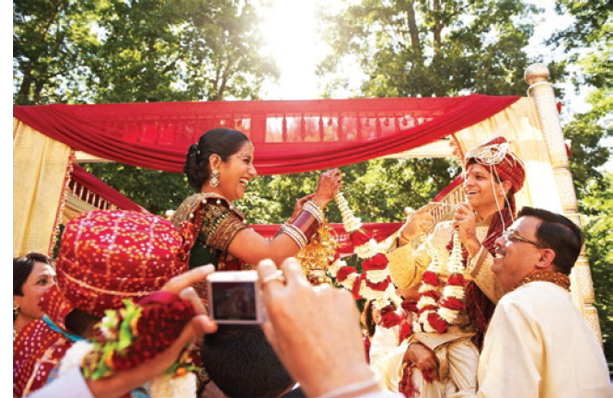Photographer: Regeti’s Photography
From their Virginia studio, Amy and Srinu Regeti handle a full range of photography clients, including about twenty-five weddings per year. Of those events, about sixty percent happen to be for South Asian clients.


Vibrant colors and ornate textures make for eye-catching images, whether the moment is celebratory or more subdued. In the bottom image, the couple “ties the knot,” joining their garments as they unite their lives.
Do Your Homework
Asked how these ceremonies differ from Christian nuptials, Amy says there’s no one-size-fits-all answer. “Every single family has different traditions. It’s just like in Christian weddings where some of us do a unity candle and some of us don’t.” Additionally, Indian clients come from an array of religious backgrounds, including Hindu, Sikh, Muslim, and Christian, lending even more variety to the proceedings.
“We’ve had to learn how to work in any lighting situation.”
This makes it important to fully understand each client’s traditions and plans. In addition to ensuring you’re ready to capture the key moments, preparation will help you avoid any missteps—or missed opportunities. For example, Srinu points out that many photographers don’t realize that the mandap (the covered, pillared platform where the ceremony takes place) is considered a sacred space, so you should remove your shoes before stepping up. The couple says they tend to treat it like an altar and shoot from the perimeter.
Prepare to Shoot Indoors
“Most of our Indian weddings are held indoors, with the ceremony and reception in the same ballroom,” says Amy, noting that this may be different in other regions. As such, they rarely encounter the large windows or room lighting found in Christian churches. Typically, the mandap is lit from below. “Nobody thinks to light the people from above, so you get that Halloween lighting effect in your images. Then we walk in and have to figure out how to deal with it. It’s really a whole different ball game—but it has made us better photographers because we’ve had to learn how to work in any lighting situation.”

Emotions transcend culture. For the parents watching their children embark upon a new life, weddings can be bittersweet. For the couple, a joyful romantic connection is celebrated with the promise for a happy life together.
Observe the Family
“I also think that a very important difference is that the focus is not just on the couple,” says Srinu. “The focus is on the whole family—brothers, sisters, cousins—everybody is going to be part of the ceremony.”
Get Ready for a Long, Involved Day
“With our Indian weddings, the ceremonies can last anywhere from ninety minutes to four hours,” says Amy. On the upside, you’re also likely to encounter a permissive attitude toward shooting. The officiants and ceremony venues Amy and Srinu work with for their Christian weddings have, over the years, tended to put increasing restrictions on photographers. “With Indian weddings, you can be in the middle of it and the priest will usually encourage you,” says Amy. This is certainly not an invitation to be intrusive, but Amy notes that it makes it possible for you to shoot freely from a lot of angles that would be unlikely during a Christian ceremony.